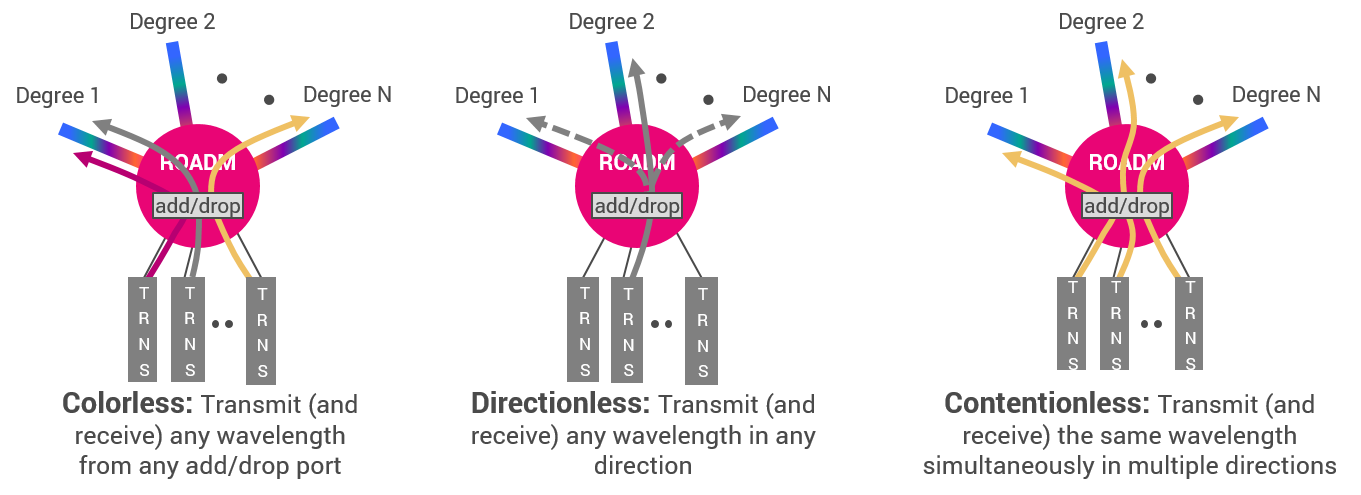At Long Last – High Performance Contentionless ROADMs
Essential to successful fiber optic networking
ROADMs (reconfigurable optical add/drop multiplexers) have been essential to the pervasive success of fiber optic networking. They enable end-to-end “all-optical” transmission of information, spanning multiple network nodes, without needing to rely on expensive optical-electronic-optical conversion. ROADMs operate simultaneously on the many (up to 100) information carrying wavelengths transmitted on an optical fiber. ROADMs perform two functions. They add/drop wavelengths to/from network nodes where customer traffic originates and terminates, and they handle transit traffic by interchanging wavelengths among fibers terminating at network nodes that go on to other nodes.
The add/drop function comes in multiple flavors known as colorless-directionless-contentionless or CDC. These deliver different types of flexibility, and combine in various combinations depending on the complexity of the optical network and the requirements of an add/drop node.
The first two CDC flavors are relatively easy to implement using broadly available tunable transponders & filters, and wavelength selective switches (WSS), respectively. Contentionless add/drop, however, has always been problematic.
Contentionless add/drop is typically required for dense networks that support many wavelengths. These arise in situations where multiple wavelengths of the same ‘color’ (i.e. occupying the same location on the fiber optic spectrum) originate at different points in the network and need to terminate or drop at a common node. For example, when multiple Enterprises across a metropolitan area all connect to a common data center. Without a contentionless capability, many lightpaths may need to be re-planned and re-implemented on different wavelength colors, consuming time and resources.
Coming back to the previous paragraph, contentionless add/drop is problematic to implement precisely because it requires that identical wavelengths – that occupy the same physical location on the spectrum – be handled in parallel within the add/drop section of the ROADM. From a purely topological perspective, there is no getting around that this requires a multistage mechanism.
Until recently, the solution has been to use a “brute force” approach with a two stage multicast switch (MCS). A typical configuration is an 8x16 MCS. Sixteen ports in the first stage add/drop individual wavelengths, and cross-connect these using 1x16 physical switches to the second stage. The second stage combines and distributes selected groups of wavelengths (making sure at this stage that there is no duplication of color) to up to 8 degrees of ROADM direction using 1x8 power splitters.
An MCS is a big bulky mess of physical switches, power splitters, and fiber wiring. Worse, it is woefully inefficient with poor performance. The two stages of switching and power splitting produce high insertion loss, which necessitates an additional external stage of amplification. In turn, this intensifies noise accumulation. In brief, no one likes using MCS for contentionless add/drop ROADMs, and due to its performance limitations, it rare to see configurations with more than 16 add/drop ports.
The good news is that a new technologically advanced approach is now available. This still uses two stages (there is no getting around that topological constraint) but these are implemented elegantly using free space optics. The first stage uses a micro-mirror MEMS array to cross-connect individual wavelengths, and the second stage uses an LCOS (liquid crystal on silicon) array to implement multiple WSS to combine and route the wavelengths to the different ROADM directions. This sophisticated approach features low insertion loss and low noise, and can easily handle upwards of 16 add/drop ports.
ECI is proud to be among the first companies to make available a high performance ROADM using this advanced design. ECI’s ROADM_8x24CDCF module powers ROADM nodes with 24 add/drop ports to 8 different directions, featuring full colorless-directionless-contentionless and flexible grid capabilities.






